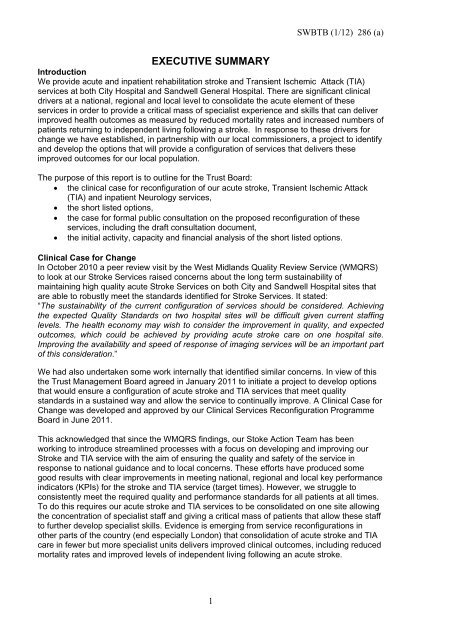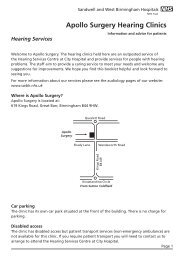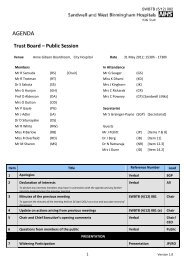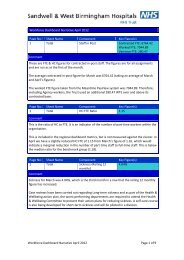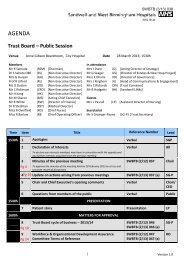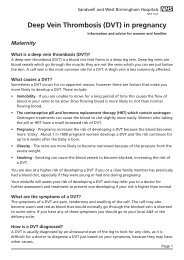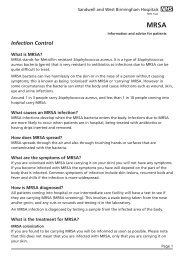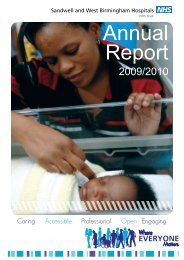January 2012 - Sandwell & West Birmingham Hospitals
January 2012 - Sandwell & West Birmingham Hospitals
January 2012 - Sandwell & West Birmingham Hospitals
You also want an ePaper? Increase the reach of your titles
YUMPU automatically turns print PDFs into web optimized ePapers that Google loves.
SWBTB (1/12) 286 (a)<br />
EXECUTIVE SUMMARY<br />
Introduction<br />
We provide acute and inpatient rehabilitation stroke and Transient Ischemic Attack (TIA)<br />
services at both City Hospital and <strong>Sandwell</strong> General Hospital. There are significant clinical<br />
drivers at a national, regional and local level to consolidate the acute element of these<br />
services in order to provide a critical mass of specialist experience and skills that can deliver<br />
improved health outcomes as measured by reduced mortality rates and increased numbers of<br />
patients returning to independent living following a stroke. In response to these drivers for<br />
change we have established, in partnership with our local commissioners, a project to identify<br />
and develop the options that will provide a configuration of services that delivers these<br />
improved outcomes for our local population.<br />
The purpose of this report is to outline for the Trust Board:<br />
the clinical case for reconfiguration of our acute stroke, Transient Ischemic Attack<br />
(TIA) and inpatient Neurology services,<br />
the short listed options,<br />
the case for formal public consultation on the proposed reconfiguration of these<br />
services, including the draft consultation document,<br />
the initial activity, capacity and financial analysis of the short listed options.<br />
Clinical Case for Change<br />
In October 2010 a peer review visit by the <strong>West</strong> Midlands Quality Review Service (WMQRS)<br />
to look at our Stroke Services raised concerns about the long term sustainability of<br />
maintaining high quality acute Stroke Services on both City and <strong>Sandwell</strong> Hospital sites that<br />
are able to robustly meet the standards identified for Stroke Services. It stated:<br />
“The sustainability of the current configuration of services should be considered. Achieving<br />
the expected Quality Standards on two hospital sites will be difficult given current staffing<br />
levels. The health economy may wish to consider the improvement in quality, and expected<br />
outcomes, which could be achieved by providing acute stroke care on one hospital site.<br />
Improving the availability and speed of response of imaging services will be an important part<br />
of this consideration.”<br />
We had also undertaken some work internally that identified similar concerns. In view of this<br />
the Trust Management Board agreed in <strong>January</strong> 2011 to initiate a project to develop options<br />
that would ensure a configuration of acute stroke and TIA services that meet quality<br />
standards in a sustained way and allow the service to continually improve. A Clinical Case for<br />
Change was developed and approved by our Clinical Services Reconfiguration Programme<br />
Board in June 2011.<br />
This acknowledged that since the WMQRS findings, our Stoke Action Team has been<br />
working to introduce streamlined processes with a focus on developing and improving our<br />
Stroke and TIA service with the aim of ensuring the quality and safety of the service in<br />
response to national guidance and to local concerns. These efforts have produced some<br />
good results with clear improvements in meeting national, regional and local key performance<br />
indicators (KPIs) for the stroke and TIA service (target times). However, we struggle to<br />
consistently meet the required quality and performance standards for all patients at all times.<br />
To do this requires our acute stroke and TIA services to be consolidated on one site allowing<br />
the concentration of specialist staff and giving a critical mass of patients that allow these staff<br />
to further develop specialist skills. Evidence is emerging from service reconfigurations in<br />
other parts of the country (end especially London) that consolidation of acute stroke and TIA<br />
care in fewer but more specialist units delivers improved clinical outcomes, including reduced<br />
mortality rates and improved levels of independent living following an acute stroke.<br />
1


